The Clear and Complete Guide to the Impact of Onboarding on Retention
Introduction
We’re in the midst of a workplace revolution, as the impact of digital collides with transformations in learning, social values, workers’ expectations, and other global trends.
Like any revolution, there will be opportunities and challenges, risks and rewards, and winners and losers.
Despite much attention being placed on rapid advancements in technology and how they are impacting the workplace, centre-stage in this workplace revolution are humans. People are at the very heart of workplaces, powering workplaces day after day and propelling them onwards and upwards.
It’s no surprise, then, that organizations worldwide continue to grapple with the perpetual issue of employee retention. How do we keep our valued employees? How do we avoid the costly impact of high staff turnover?
Research shows many industries, including tech, retail, media and entertainment, professional services and finance and insurance, are impacted by higher-than-average staff turnover rates. Other research shows that turnover rates, generally, have been on the rise in the last decade.

Don't have time to read it all now?
Use the form below to unlock a handy PDF version of this guide you can reference later.

Staff leave for a tangle of reasons and the complexities of each industry and workplace make the issue even more difficult to unravel and address. However, one thing is emerging as a critical factor in keeping people put – and engaged – in their workplace day after day, week after week, and year after year:
Onboarding.
Research suggests up to 20% of new hires leave in the first 45 days of employement, putting a giant question mark over the effectiveness of the onboarding programs those early leavers experience. Further, 69% of employees say they are likely to stay with a company for at least three years after a great onboarding experience.
Here, we delve into the complexities of employee retention and look at how better onboarding can drive your organization towards that workplace ideal of consistently-low staff turnover.

Are your employees sticking around?
If your new employees are quick to exit your business, it’s hurting your organization’s bottom line. It’s that simple.
However, it’s bad for business beyond the obvious costs of finding, hiring and training replacement staff.
When an employee walks out the door, it impacts your business immediately – and you also lose everything that employee would have contributed to your business over the next few years, perhaps even decades. You lose the business knowledge that’s in their head and the relationships they’ve built with colleagues and stakeholders. A general disruption in the day-to-day flow of the organization is also a by-product of high staff turnover. It can be a major distraction for people who should be focused on working towards the organization’s mission and goals.
A recent literature review outlined more potential downsides that can come with high turnover: harming customer service and quality, compromising competitive advantage, and leading to lack of motivation and low morale within the organization.

Staff retention is the ability of an organization to keep its employees. A retention rate of 87% means a company of 100 employees kept 87 of them during the year.
Staff turnover is the percentage of employees who leave an organization during a certain period of time.
If an organization has 100 employees at the start of the month and four people leave during the month, the turnover rate is:
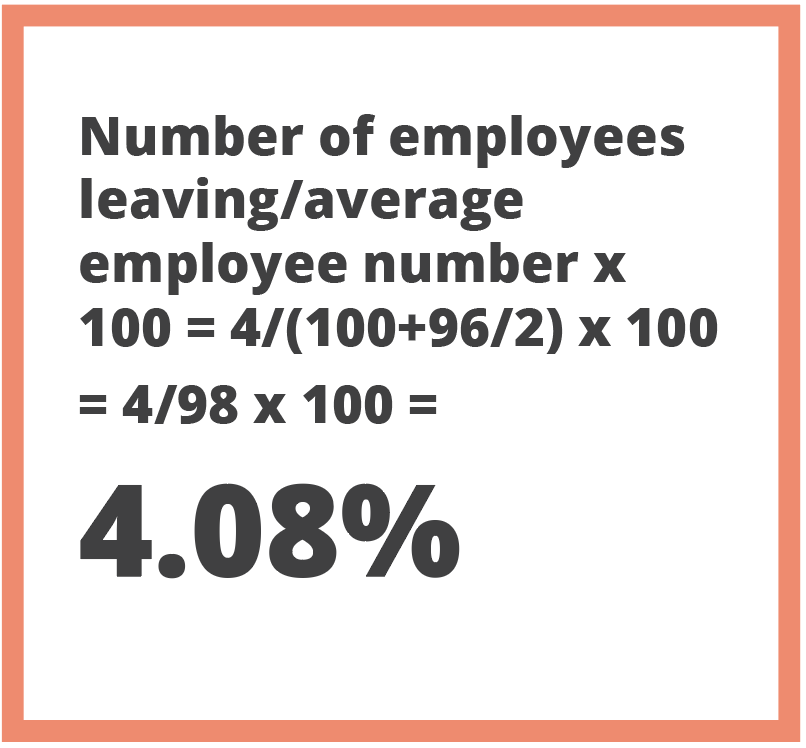
According to analysis by LinkedIn, the worldwide average staff turnover rate is 10.9%, with these industries struggling with higher than average rates:
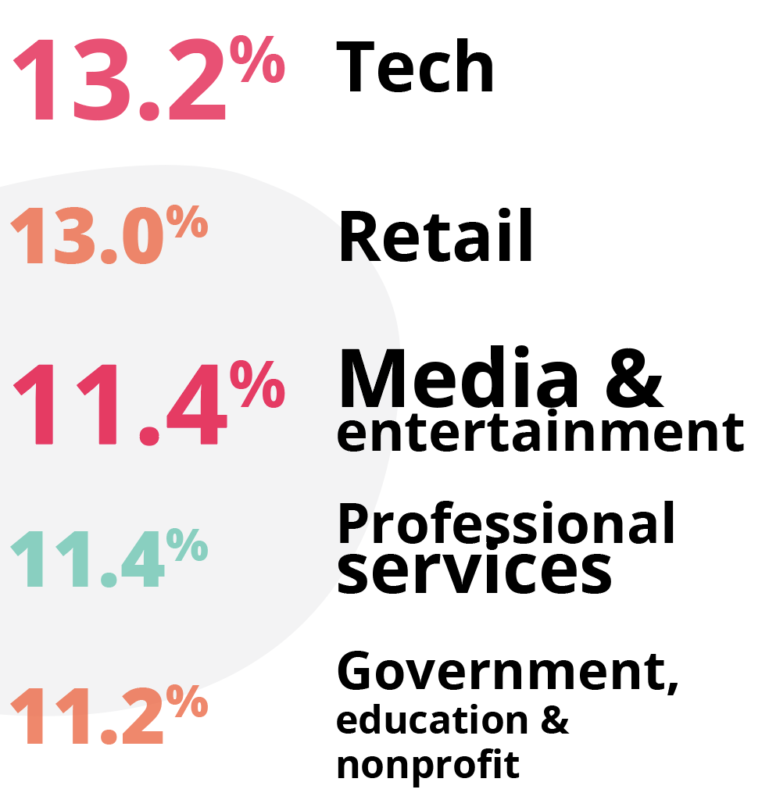
Financial services and insurance and the telecommunications industries have rates hovering around average.
While some turnover is a natural and normal part of a healthy organization, high turnover is a red flag. It begs the nagging question,“why?”
While turnover rates have been on the rise recently, to get an understanding of organizational churn, you need to also look closely at industry trends and organization-specific issues.
Are industry trends to blame?
Some industries just seem to attract job hoppers.
Retail, for example, has a reputation as a high-churn industry. There are quite a few things at play here. The pay is typically low and there are plenty of other stores that might pay just a little more. Often, it’s a “first job” for younger people who don’t plan for retail to be their longer term career choice. Also, managers are often promoted from sales positions and may not be great natural people managers. Training, development and onboarding can also get neglected as organizations recruit during busy periods and push to get their retail people productive.
In the tech industry, on the other hand, commentators suggest problems retaining talent may be more about high demand and rising compensation within the industry generally, with top talent “eager to jump on new opportunities... as employers and offers get more competitive.”
Meanwhile, project-based industries like media and entertainment, may see staff come and go as projects start and end9.
Or is it something coming from within?
Once you get a picture of the industry landscape, it’s time to look within for reasons your front door seems to be a revolving one.
You need to ask some serious questions:
- Are people leaving because they weren’t the right people for the job?
- Did their expectations not match the reality?
- Was the cultural fit not right?
- Are they leaving for better pay? Or better growth opportunities?
- Is pervasive low morale creating a path to the exit door?
- Are they simply leaving a good job for a great one?
Whatever the reason, there are things that you can do to improve staff retention rates - and understanding the underlying factors can help focus on what will have the biggest impact in your organization.
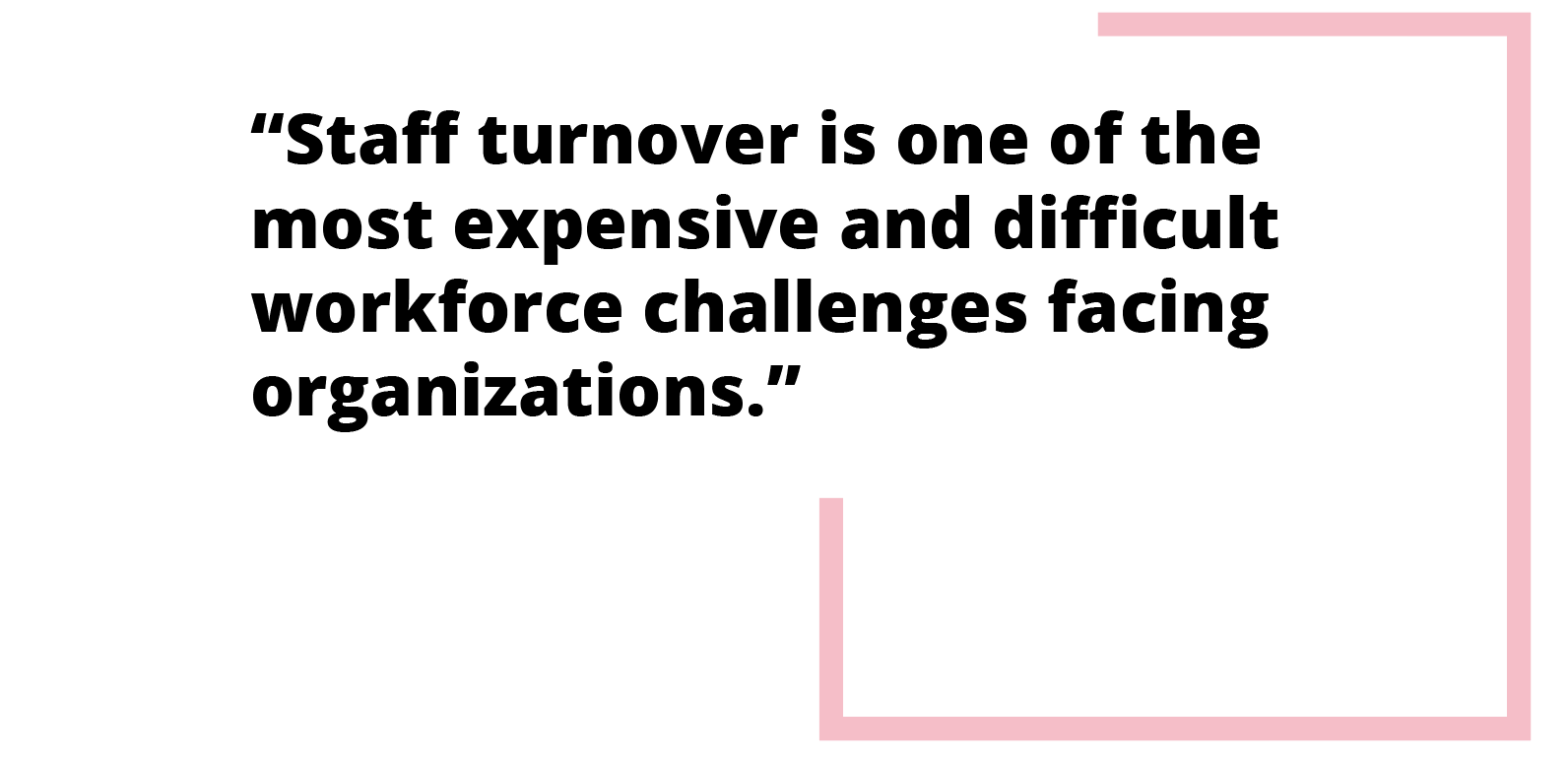
The Changing Face of Employee Retention
So, you’re recruiting the right people for the job, you pay industry or above rates, you’ve got flexible work policies and an incentive system. But staff turnover is still higher than you’d like.
What do employees want in 2019? What will make them happy and satisfied enough to stay?
The key to dealing with employee retention is to understand its close relationship with employee engagement and employee experience.
Highly engaged employees are more likely to stay with their employer.
In organizations with high employee turnover, highly engaged business units achieve 24% lower turnover.
In organizations with low employee turnover, highly engaged business units achieve 59% lower turnover.
When we consider that 85% of adults worldwide are not engaged or are actively disengaged with their work, the frustrating issue of high staff turnover comes into sharper focus.

"Engaged employees are highly involved in and enthusiastic about their work and workplace. They are psychological ‘owners,’ drive performance and innovation, and move the organization forward."
Gallup's State of the Global Workplace
Looking at employee retention through the prism of employee engagement.
Focusing on employee engagement, as a means to improve employee retention, makes sense. The issue of engagement is something that filters through every aspect of the workplace and employee lifecycle. It impacts not just retention but absenteeism, productivity, shrinkage, safety, customer metrics and – ultimately – profits.
So, the question becomes, “What do employees need to become, and stay, engaged with their work?”
Once the basics like being able to work flexibly and pay increases are covered, three things stand out according to one study:
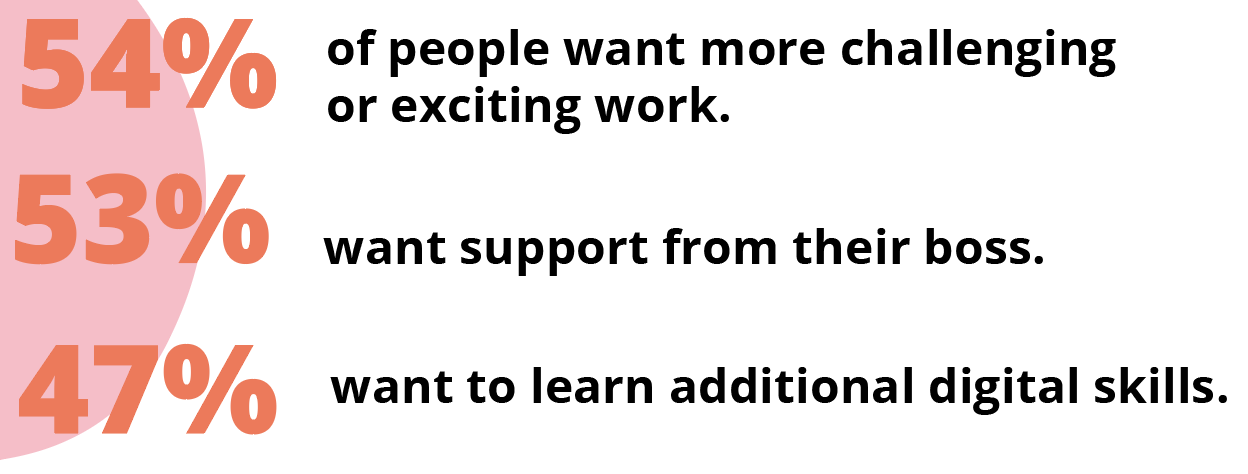
Gallup’s State of the Global Workplace echoes a similar sentiment, suggesting employers focus on employee development, identifying and leveraging employee strengths and helping people see purpose in their job beyond the paycheck.
If we look at what millennials, the generation with a reputation for job-hopping, want then things become even clearer.
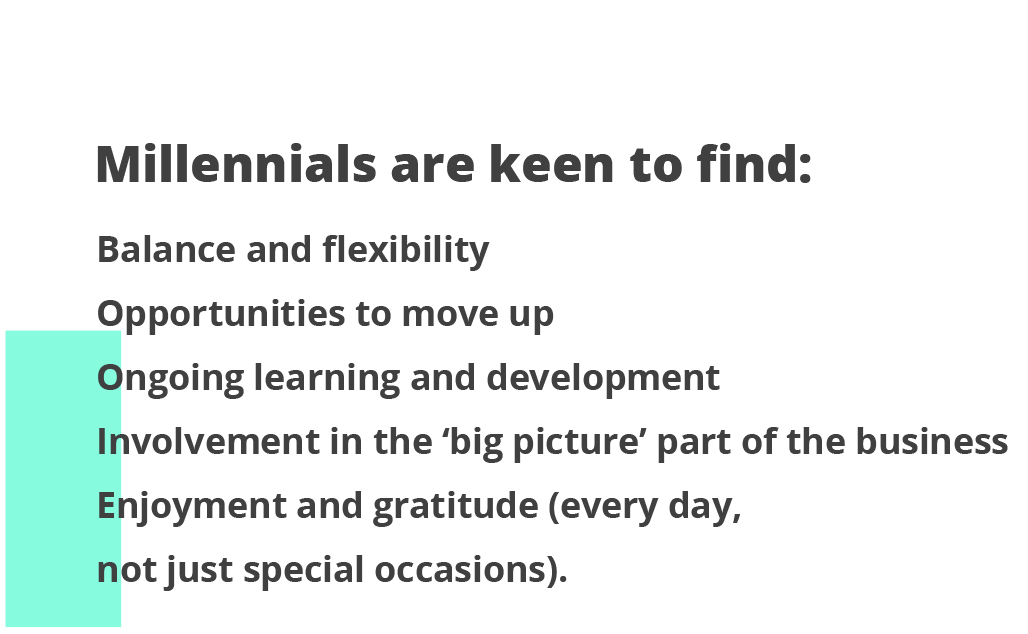
Looking at these studies, three themes start to emerge.
Employees today are craving:
Progression and development
Support and connection
Alignment and purpose
If we know what employees are craving and what will help us keep them engaged, what’s going wrong?
Why are engagement levels, globally, so low?
Like we said at the start of this paper, there are so many changes going on that we’re actually knee-deep in a workplace revolution. Experts agree that this can have an enormous impact on engagement, productivity and retention, saying resistance to change is an underlying issue that’s hitting workplace engagement levels:
“Organizations and institutions have often been slow to adapt to the rapid changes produced by the spread of information technology, the globalization of markets for products and labor, the rise of the gig economy, and younger workers’ unique expectations.”
Digital, in particular, has changed everything and mastering its use and place in the workplace is arguably the key to higher engagement levels.
Learning to use the power of digital
Changes are occurring so rapidly that organizations can struggle to keep up. Employees are expecting the same great tech at work that they may be used to at home.
“These days consumers are seeing technology show up in all walks of their lives, from booking their tickets on planes to self parking Teslas in their garages. They are demanding easier and intuitive experiences using the modern day technologies of cloud, mobile and AI.
Technology, if created wisely, can also provide a better platform for diversity and inclusivity in all talent practices.
Technology is now seen as the accelerator for democratising HR. Cloud-based solutions are asking for simplification of processes, and placing much in the hands of employees and managers. HR tools are now the harbingers of culture change within the company.”
-Rajamma Krishnamurthy, Director HR Technology, Microsoft
While great digital solutions have the power to free us from the mundane, give us back time, provide insights and connect us, we’re still craving that human touch - perhaps more than ever.
Why Onboarding Matters More Than You May Think
To give employees what they want, and to get them (and keep them) engaged, there’s an obvious place to start. The beginning.
Onboarding defined
Onboarding helps new recruits get acquainted with their new organization, adjust to all aspects of their new role and reinforce that they have made the right decision to join.
It propels them beyond “newbie” status to become a productive employee who understands the organization’s purpose and their role and is able to form strong workplace bonds.
If you’re still thinking of onboarding as a one week orientation period, it may be easily dismissed as just another box to tick and something the HR people can look after.
To understand the impact it can have, we must re-frame our understanding of what onboarding actually is.
Your onboarding program may run for one day or one year. However long it runs, it’ll affect the employee’s entire experience at the organization and how they perceive (and talk about) your brand.
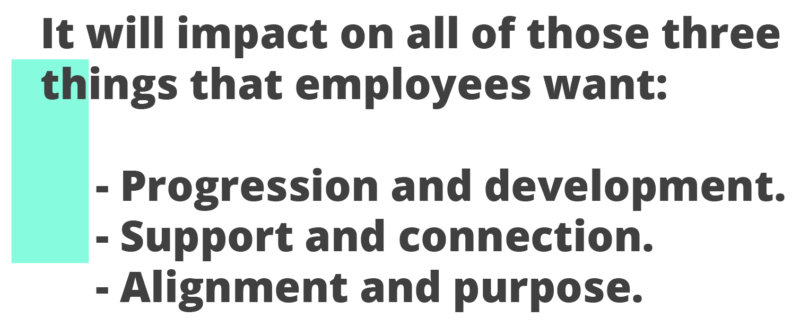
So, if your onboarding is a one-day affair, it may be time to consider its role within your organization.
How organizations can benefit from better onboarding.
It’s not just new recruits who are impacted by onboarding, though. Research shows organizations that invest time and resources to improve the quality and scope of their onboarding process consistently outperform the rest:
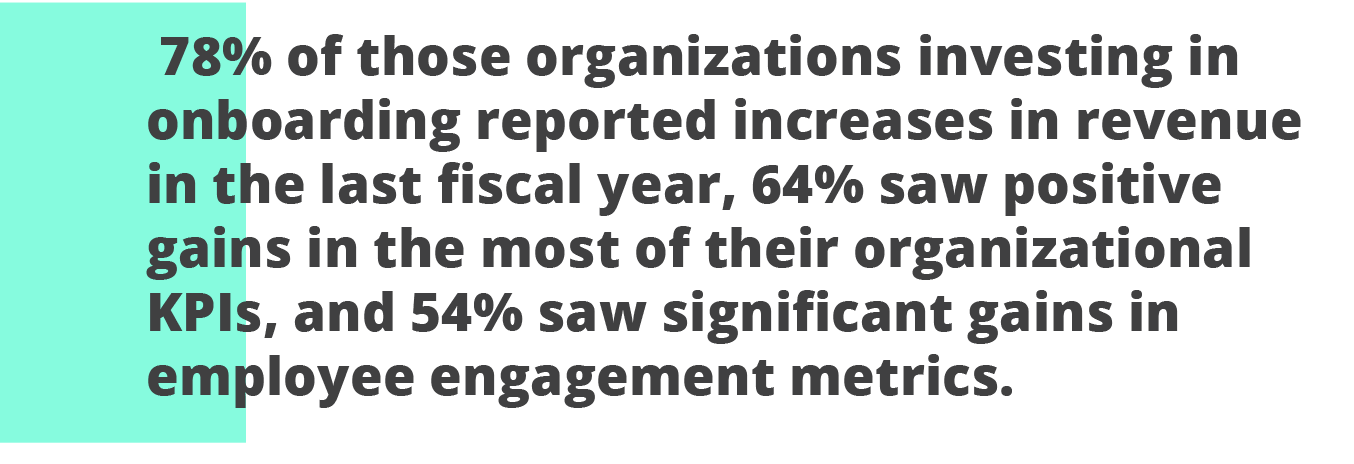
Still not convinced?
Here are some more stats:
- Twenty-two percent of employees say they’d look for another job if they didn’t receive a good induction and onboarding while a further 41% admitted they might look elsewhere
- Fifty-one percent of employees say they’d go “above and beyond” if they were given a good induction and onboarding, with another 33% ‘maybe’ doing the same.
- Invested onboarders get better talent outcomes and are twice as likely to report faster times to proficiency for new hires, while 78% say onboarding is a continuation of a positive candidate experience.
And a final stat which links onboarding directly to turnover:
- Sixty-four percent of invested onboarders report decreased turnover, compared to 37% in other organizations.
Whether you’re in sales, where faster times to proficiency are a drawcard, or tech, where simple talent retention counts, it’s clear that onboarding can impact the whole business and be a key factor in driving your business beyond the challenge of retention - so everyone can focus on the forward journey.
“At Google, we front-load our people investment. This means the majority of our time and money spent on people is invested in attracting, assessing, and cultivating new hires.”
- Laszlo Bock, former Senior Vice President of People Operations at Google
The Preboarding experience
Preboarding is the time between the new hire accepting the job and their first day on the job.
Initial impressions count, and high-performing companies know it – 83% of high-performing companies begin their onboarding process before an employee’s first day on the job.
Preboarding can also help you onboard more effectively, as you can get some of the paperwork out of the way and make the first day filled with energy and fun.
It’s also a chance to capture the excitement and enthusiasm they’re feeling about being offered a new role.
Remember that it’s about more than information and paperwork. Why not invite your new hire to lunch before they even start? Or send them some organization-branded gifts to add a sense of belonging before they enter the door? You can also help them get over any nerves by sending through a first day schedule.
“Every employee deserves the opportunity to become successful in their job - to feel a fuller sense of meaning with their working life. Without a flying start in a new job, chances are that person will not deliver on expectations and will not feel their work is meaningful. This is a vital task for any HR department and manager. It helps create a meaningful working life for people and helps them to succeed. And with the individual success of each employee, you help companies grow and reach their goals. In this way, onboarding of new hires is critical for success.”
- Laszlo Bock, former Senior Vice President of People Operations at Google
What Should Onboarding Look Like In 2019?
If your approach to onboarding looks like it did five years ago, you’re doing it wrong. An ad hoc, checklist approach just doesn’t cut it in today’s environment.
Today’s onboarding should put a spotlight on the new hire’s experience and engage new hires before day one even arrives. It should be thoughtful, and treat employees more like customers. We call this experience-driven onboarding.
Experience-driven onboarding
There are three important steps in moving to experience-driven onboarding:
1. Create onboarding superstars: your managers
It’s often said that people don’t leave jobs, they leave managers. Gallup estimates managers account for at least 70% of variance in employee engagement scores across business units - suggesting this saying has more than a hint of truth.
However, a recent study of more than 350 organizations found that 57% of HR leaders say managers lack the time and bandwidth to support, implement and improve the onboarding process.
2. Let your new employee shine
What is the one thing your new hire can do better than anyone? If you don’t know, ask them! Take advantage of the preboarding phase to get an understanding of your new hire’s unique personal strengths, experiences, and career goals.
Also ask them what makes them happiest at work and what conditions turbo-charge their performance. Talk about values, traits, skills and tasks.
Encourage managers to talk to new recruits about how they can put their superpowers to use in their new role and how they can spend more time doing what they love. Empower your new hire to connect with their role and make it their own.
3. Help new recruits build solid foundations and lasting connections
Your onboarding process should be sleek and shiny, streamlining and automating the mundane to make room for meaningful connections. Remind managers to introduce new hires to colleagues and key contacts early. Make it more than a hello and handshake - you need to encourage stronger connections that’ll last. Talk about shared interests, backgrounds and how the new recruit will help the organization. This helps new hires to build their social workplace identity around their authentic strengths and values.
Again, we simply need to change this. And there are plenty of ways to shake things up:
- Educate managers on the organization-wide impact onboarding has on things like engagement and productivity
- Incorporate it into their KPIs Ask for their input during the development, implementation and review of your onboarding program
- Get a buddy involved to free up some of the manager’s time
- Use technology to automate the mundane processes and free up even more time.
“To help ensure new hires are connecting early on, best-in-class companies are 39% more likely than others to measure employee engagement with onboarding to ensure they understand what's expected of them.”
- Human Capital Management: An employee-centric digital workplace: from onboarding through engagement and retention
Onboarding essentials
Are you asking all the right questions about onboarding?
Remember, a truly experience-driven onboarding program will also look at things from an employee’s perspective.
| Stage/Timing | Manager's POV | Employee's POV |
|---|---|---|
| Offer | Is all the paperwork in order? How can we get this new employee up to speed as quickly as possible? | Is this the right job and company for me? Did the letter and contract arrive as expected? |
| 2 weeks before start date | Will everything be ready for the new hire’s first day? Business cards, paperwork, workspace, parking, tools… can this all be organized with minimum fuss? Does the new hire know about all the workplace rules and regulations? | I’m starting to feel a little nervous. I wonder what my new job will really involve? I wonder what my new manager and co-workers are really like? |
| 1 week before start date | Is the start date confirmed? Are the tools, tech and timelines in place for the first few weeks? Have you sent a welcome email or call with first day agenda? | I wonder what will happen on the first day? |
| Day 1 | Did we get all the basics done? Have we made a good impression? Does the new hire have all the right resources (technology, building, contacts, desk)? | Will I get a warm welcome? If I’m lucky, perhaps I’ll get a welcome pack and a morning tea or lunch to celebrate. |
| Week 1 to 30 days | Is the paperwork complete? Is everyone, especially the manager, engaged in the onboarding process? | Do I understand what’s expected of me and what the role involves? Do I know who to talk to if there’s an issue? Does my supervisor care about me? |
| 30 days to 60 days | Is the new hire settling in okay? Are there still teething issues that need to be addressed? | Am I starting to actively contribute to the team and business? Do I know where to go with any unresolved issues? |
| 30 days to 60 days | Is the new hire starting to contribute to the organization’s overall mission? | How can I do better in my job? How can I make this role mine? Do I have a work bestie? |
| 30 days to 60 days | Is the new hire now an engaged and productive employee? Have we discussed performance, career goals and opportunities? | Am I doing what I do best every day? Do I love my job? Can I see myself here for another year, 2 years and beyond? Can I keep learning and growing? |
The role of technology
While digitizing parts of your onboarding won’t improve engagement on its own, it will free up valuable time to take a more strategic approach to onboarding.
With two in five organizations currently using a dedicated onboarding technology solution and another 18% planning to acquire one in the next 12 months28, we are on the brink of a rise in experience-driven onboarding.
What Does Onboarding Actually Look Like In 2019?
Despite the convincing case for onboarding, and everything we know about what it should look like, the reality is that onboarding is less than ideal in many organizations.
Missed opportunities
- More than two in three organizations say onboarding practices are underutilized
- Less than half say their onboarding is effective in retaining new hires
- In most organizations, onboarding stops after week one.
Organizations continue to struggle with onboarding for a variety of reasons.
First, there are the inconsistencies to contend with. With varying locations and roles, HR professionals say setting up a standard and consistent framework can be challenging.
Then there’s the perennial problem of failing to understand onboarding and its impact. Organizations often place too much emphasis on new hire paperwork, neglecting strategic activities for long-term success. They also fail to devote enough time and resources, with more than a third of organizations saying onboarding lasts from just a few hours to only one week.
Another problem of plague-like proportions is ownership. Who is accountable for the success (or failure) of onboarding? Who really “owns” onboarding within your organization?
Do you see it as an HR issue? Something for someone else to deal with? If you’re still thinking like that, you’re forgetting everything you’ve just read on the earlier pages.
Something needs to change. And everyone needs to work together to change. What are you waiting for? There are giant leaps to be made.
What Could Your Onboarding Look Like In 2019?
Where are you right now with onboarding?
What’s your employee survey data saying about new hire engagement within their first 12 months (and generally)?
What’s your data saying about employee turnover within their first six months?
What’s your employer net promoter score (eNPS)?
If your answers leave you feeling deflated, that’s okay. What you’ve got here is a framework for change. Okay, are you ready?
Here are some stories that’ll give you even more motivation to change - and make your onboarding a powerful retention and engagement tool.
Case Studies
Case Study 1
Gerhard Schweinitz
Head of Talent
![]()
“Contino is a global technology consulting firm. We specialize in enterprise transformations, which involve transformation strategies not only around technology, but also people and processes.
As a consultancy, we advise our clients that modern tech stacks not only help them with their business requirements, but also assist with attracting and retaining talent.
Onboarding is a critical part of welcoming new team members to the Contino family. We want to create relationships through this process and also enable each new starter with the information they need to succeed in their position.
Onboarding is a team effort, creating a culture where everyone is welcoming towards new employees is critical. Leaders need to get to know their new starters, otherwise they will be on the back foot when managing their team members moving forward.
We want to understand each new starter's drivers and career objectives during onboarding, so we can help both their personal and professional development during their employment tenure at Contino.
From an attraction perspective, word travels fast in the tech community, good or bad. If you create a positive experience for your new starters, they will spread the word and the talent will follow.”
During onboarding, our focus is on setting up new starters to succeed. Success leads to positive feedback, which leads to employee well-being and retention.
We also listen to the employee's needs during onboarding to help enable them on a professional development plan during their time at Contino – this is another important driver that builds loyalty.
From an attraction perspective, word travels fast in the tech community, good or bad. If you create a positive experience for your new starters, they will spread the word and the talent will follow.”
Case Study 2
Rajamma Krishnamurthy
Director HR Technology

“In the last few years, Microsoft has made some huge leaps in onboarding.
Understanding that it takes a village to onboard an employee to the company and role in a company our size, there has been a great attempt to stitch the story end to end, and hold each party accountable to both quality of experience as well as timeliness.
Onboarding in Microsoft starts the day the employee gets the offer and continues about 6 months after the employee joins the company.
Ensuring a warm connection during the days before they join, to having a productive ID and laptop on day one, as well as an energizing new employee orientation, are some of the strides we have made.
In addition, getting feedback from employees and managers throughout this journey keeps making this program better each week as thousands of employees throng to Microsoft around the world.
Competition for good talent has made having great experiences in both recruitment and onboarding imperative for companies. To vie for this talent and to secure and retain them, especially in the era of gig economy, is getting more and more difficult and impossible. It is important that companies pay attention to this often ignored population of candidates who will become employees with a mentor who can help the employee navigate the culture of the company, while also ensuring that the employee has all the tools they need to succeed in the company.”
Case Study 3
Elizabeth Pierce
Director Learning & Development

“Our company mission is to bring people together through live experiences, and that begins with onboarding. It plays a huge role in helping us attract and also keep the right people at Eventbrite.
It’s so important that the process parallels our culture from start to finish and provides the right introduction to the business.
The talent economy, particularly in the Bay Area, is getting even tighter and everyone is competing to get the best people. Once you get them in the door, people will not hesitate to leave a business if they are not engaged or if the job doesn’t meet expectations. It’s not just about having great technology and tools, but a focus on setting and communicating clear expectations for every new role.
At one of my previous roles it was understood that if we had 30 people start on one day, only 20 or so would still be there after the first two weeks. It was clear from my own onboarding journey at Eventbrite that they were far ahead of the industry in truly understanding how to put employee experience at the centre of the process.
Onboarding is even more important when you have a geographically-diverse workforce.
The balance between consistency and personalisation is very important - as our business has grown we’ve taken great care to articulate and implement the ‘baseline’ onboarding experience for all new starters and ensure we continue to connect with them throughout their journey with us.
On top of that baseline we make sure that the onboarding experiences are as personal as possible, including localising content and activities to match the different office locations.
It’s important to listen and gather data to really understand the employee lifecycle and where the issues could be - we’re now at that stage where we have that complete picture and are seeing great feedback from our people.”
Conclusion
Improved engagement and employee retention are goals worth striving for. If, until now, your efforts are having a less-than-stellar impact, it may be time to change the way you’re doing things.
Instead of throwing your engagement budget and efforts at comfy co-working couches, fruit baskets, and ping pong tables, put your money where your employees will notice it most from day one. Onboarding.
To turn onboarding into a powerful retention tool:
- Accept that it’s time to change and get the wheels in motion.
- Reframe your views about onboarding.
- When designing your onboarding program, think about it in terms of your new employee’s experience rather than as a checklist.
- Train your managers to be great at onboarding.
- Digitize your onboarding to reduce paperwork, free up manager time and provide space to unlock bigger goals and strategies.